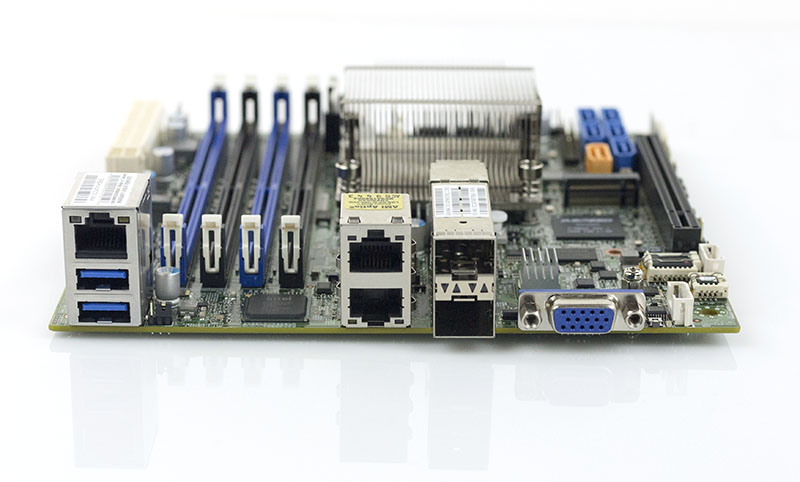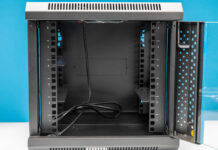The Supermicro X10SDV-12C-TLN4F+ is a compact yet extremely powerful platform. The motherboard is a slight variation on the Supermicro X10SDV platform that we are accustomed to seeing. Instead of utilizing dual 10Gbase-T ports, the “+” version has two SFP+ 10GbE ports. While 10Gbase-T is excellent for integrating with existing copper networks, SFP+ is a better option for integrating with higher-speed networks. From a motherboard point of view, the SFP+ cage is much larger than a 10Gbase-T port housing however Supermicro managed to maintain functionality while including a larger port. Looking at compute, the motherboard features an Intel Xeon D-1557 processor. That CPU may look small but packs 12 cores and 24 threads into a paltry 45W TDP. As you will see in our review, the combination of SFP+ 10GbE and a 12 core CPU is extremely powerful.
Test Configuration
We used a similar configuration to our other Intel Xeon D platform reviews.
- CPU: Intel Xeon D-1557 (embedded)
- Motherboard: Supermicro X10SDV-12C-TLN4F+
- Memory: 128GB – 4x Samsung 32GB DDR4 2133MHz ECC RDIMMs and 64GB – 4x 16GB DDR4 2133MHz configurations
- SSD: 6x Intel DC S3700 400GB, 1x Samsung XP941 512GB, 1x Intel DC P3600 400GB (add-in HHHL card)
- Operating Systems: Ubuntu 14.04.4 LTS, Ubuntu 16.04 LTS, CentOS 7.2
We purposefully loaded up the system with SSDs just to ensure that all slots would operate if populated with storage. With a 12 core / 24 thread processor we strongly recommend configurations with 128GB RAM (4x 32GB) as that is only about 10GB/ core or 5GB/ thread. We pulled all but an OS SSD for power testing to be consistent with other results.
Supermicro X10SDV-12C-TLN4F+
The Supermicro X10SDV-12C-TLN4F+ is a mITX motherboard that fits in a 6.7″ x 6.7″ form factor. Despite the diminutive size, it has a CPU, dual 10Gb SFP+ Ethernet, dual 1GbE ports and significant expansion capabilities.
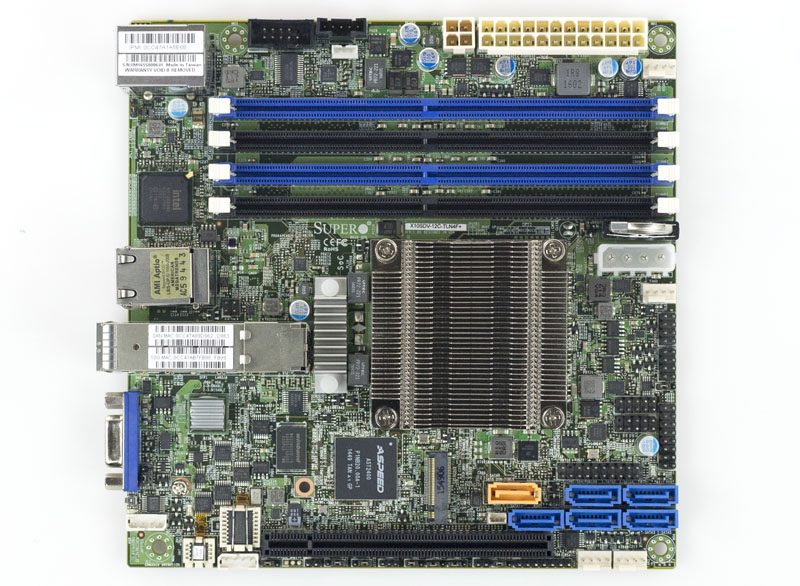
The onboard Intel Xeon D-1557 has 12 cores, and 24 threads thanks to Hyper-Threading. L3 cache is down to 18MB or 1.5MB per physical core. The 45W TDP is similar to the Intel Xeon D-1541 8 core / 16 thread processor. To fit more cores into the lower power envelope, Intel lowers clock speeds to 1.5GHz base and 2.1GHz maximum turbo frequency. We recently published Intel Xeon D-1557 benchmarks, but the basic summary is that for single-threaded workloads the Intel Xeon D-1541 is a better processor. For highly threaded workloads the D-1557 offers more raw performance. From a platform perspective, one still has the dual Intel X552/ X557 10Gb Ethernet MAC onboard, the same PCH (for USB/ SATA) and PCIe configuration.
Like other X10SDV motherboards, the mITX motherboard follows front to back airflow. The Supermicro X10SDV-12C-TLN4F+ utilizes a fairly large passive heatsink. This is not meant to be cooled passively. Rather it is meant to be used in conjunction with chassis fans to keep the CPU cool.
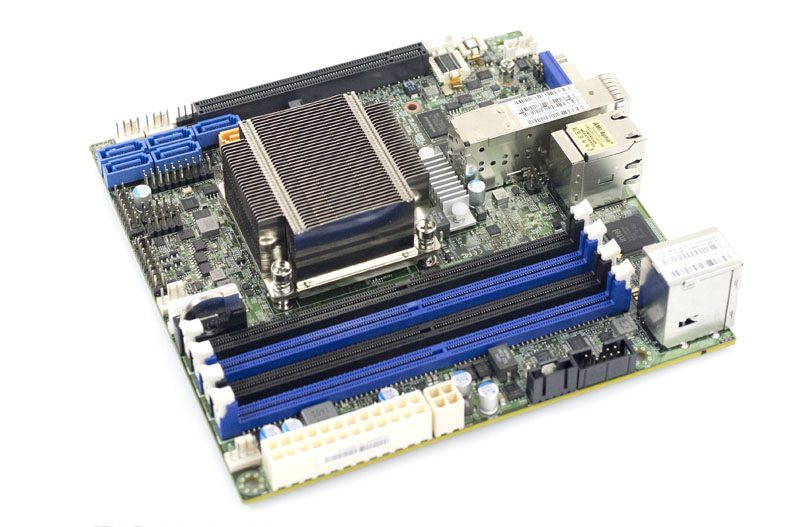
The latest Supermicro X10SDV motherboards have four or more 4-pin PWM fan connectors. Old versions only had three. Two to four chassis fans are recommended to get sufficient airflow over the heatsinks.
In terms of expansion, there is a m.2 PCIe SSD slot that sits above the Aspeed AST2400 baseboard management controller. When adding the larger SFP+ cages, Supermicro did need to make modifications to the mITX layout to still be able to fit a m.2 slot on the motherboard. Next to this is a PCIe 3.0 x16 slot. When selecting a 1U rackmount chassis, you will need to ensure that the expansion slot lines up to the first PCIe slot point. We have used Supermicro SC505 and SC504 chassis with success.
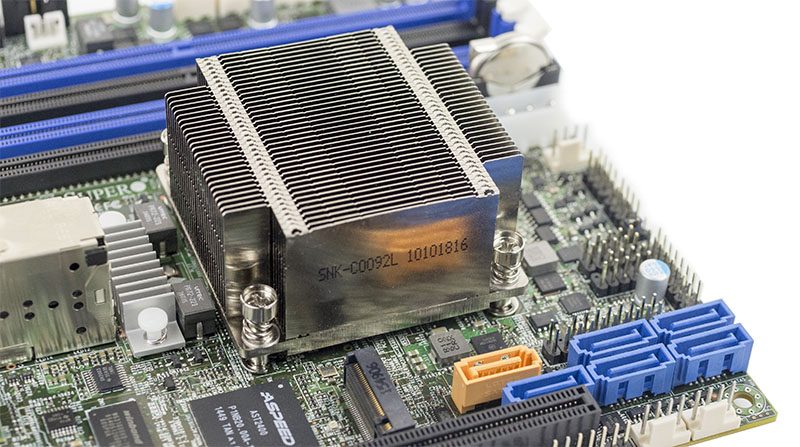
Onboard SATA from the Xeon D-1557 SoC’s onboard PCH comes in the form of six SATA III 6.0gbps ports. The yellow/ orange port supports SATA DOM power and there is also a SATA DOM power connector just next to the port. We use SATA DOMs on the Supermicro X10SDV motherboards we use to host STH. The additional five SATA III ports provide ample storage for the dual core machine.
The rear I/O is the higher-end solution from Supermicro. It includes an Intel i350-am2 Ethernet controller which is a relatively expensive 1GbE controller and has a very popular feature set. Next to these are the two SFP+ cages. They allow 10GbE connectivity using either passive DACs or optics for longer runs. With the latest OS versions (e.g. Ubuntu 16.04), this works great because the Broadwell-DE Intel X552/ X557 drivers are included. If you are using older OS versions you will likely need to load the latest Intel ixgbe drivers.
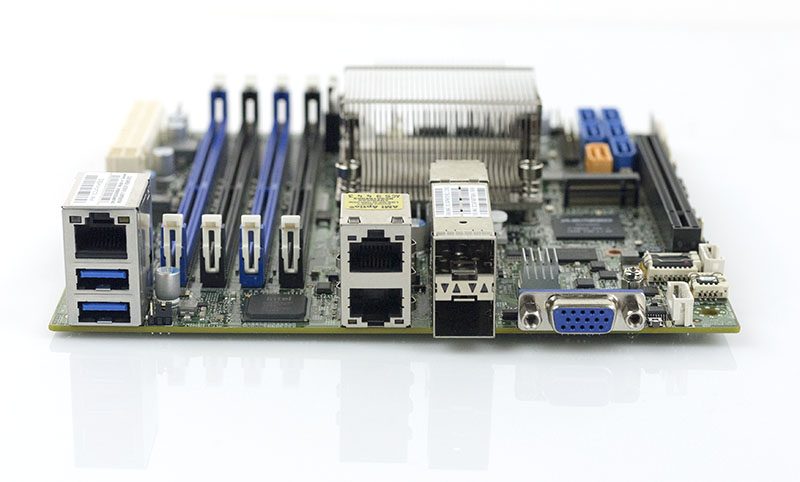
Rounding out the rear I/O there is an out of band management Ethernet port. One can also see a VGA console output and dual USB 3.0 ports for local KVM access.
Power Consumption
We used our Extech TrueRMS Power Analyzer 380803 to take measurements at different points of the board’s use.
- BMC only power off – 4.8w
- Ubuntu 14.04 LTS installation screen – 31.3w
- UnixBench 5.1.3 single thread max – 36.7w
- Max observed – 109.1w
These are excellent results and this is certainly a testament to the platform. Loaded with SSDs for an all-flash Ceph node or with a USB key/ SATA DOM for a network appliance that is a lot of platform in a very low power envelope.
Remote Management
Supermicro’s IPMI and KVM-over-IP as described a few times on this site, allows for a lot of deployment flexibility. Things such as fan speeds, chassis intrusion sensors, thermal sensors, and etc. can be monitored remotely. Alerts can be setup to notify the admins of issues. Beyond this, the functionality also allows for remote power control. One can do remote power up, power down, and reset of the server in the event that it becomes unresponsive.
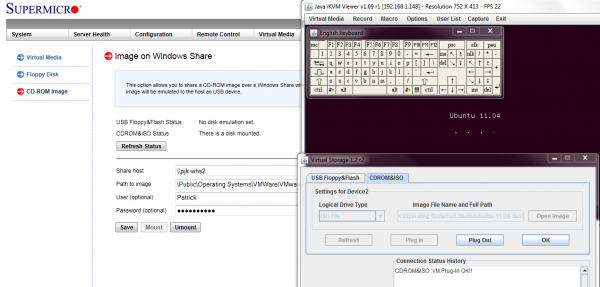
Another important feature is the ability to remotely mount CD images and floppy images to the machine over the dedicated management Ethernet controller. This keeps maintenance traffic off of the primary Intel NICs. At the same time it removes the need for an optical disk to be connected to the Supermicro motherboard.
The latest revision of Supermicro’s BIOS has a great feature: the BMC IP address shows up on the post screen! This is a super feature because if one has a KVM cart hooked up to the system, it gives an indicator of which machine one is connected to during post.

Supermicro does include KVM-over-IP functionality with the motherboard. We have been testing servers from HP, Dell, Lenovo and Intel that all required an additional add-in key to get this functionality. It is an absolute time and money saver in the datacenter and other vendors should follow Supermicro’s lead in this space.
Conclusion
Overall, this is an awesome platform for someone looking at a compact, 1U appliance. The ability to fit 12 cores in a very short depth appliance with 2.5″ SSDs, a NVMe SSD (M.2), a PCIe 3.0 x16 expansion slot and built-in 10Gb SFP+ Ethernet is phenomenal. With the 45w TDP this is feasible to cool in a small chassis whereas the 12 core Intel Xeon E5-2650 V4 (105w TDP) is much harder to cool. We are big fans of using SFP+ networking as we have transitioned the STH / DemoEval lab to mostly 40GbE. With SFP+ we can use inexpensive breakout cables from our energy efficient 40GbE switches rather than using higher power 10Gbase-T. As savings of single digit watts per node is less exciting for 500w nodes but in Xeon D-1557 nodes that can mean 5-10% power savings or several more nodes per rack. The one question buyers should look into is whether their applications will work with more/ slower cores on the D-1557 versus fewer/ faster cores on the D-1541. There is a very noticeable delta in single-threaded performance between the two solutions. Overall, if this motherboard were available when we built the recent iteration of the STH hosting cluster we would have added several Supermciro X10SDV-12C-TLN4F+ node storage Ceph storage cluster.
Want to try the Supermicro X10SDV-12C-TLN4F?
We are adding this Supermicro X10SDV-12C-TLN4F to our DemoEval platform starting 5 December 2016. Now you can run your own workloads, try the management interfaces, check software compatibility for a few months after we review a platform. Click here next week for more information:

